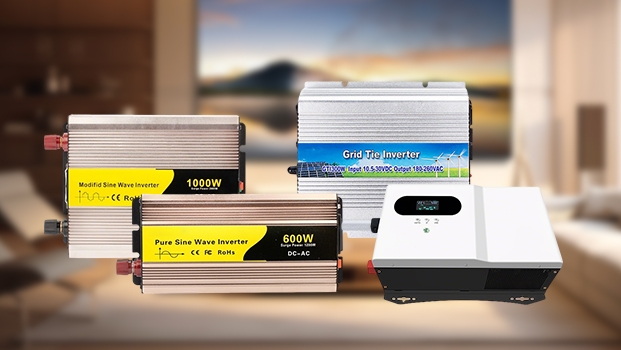In today's modern world, where uninterrupted power is essential for daily life, power inverters have become a crucial part of many households. Whether it's a sudden power outage or the need for consistent electricity in off-grid homes, an inverter ensures you have reliable backup power. However, choosing the right inverter for your home isn't as simple as picking one off the shelf. It involves understanding your energy requirements, the types of power inverters available, considerations, and much more.

What Is an Inverter and Why Do You Need One?
An inverter is an electrical device that converts direct current (DC) into alternating current (AC). Since most household appliances and electronic devices operate on AC power, inverters play a critical role in systems that use DC sources, such as batteries or solar panels. For example, solar energy systems generate DC electricity, which needs to be converted to AC before it can power appliances or be fed into the electrical grid. Their capacity is measured in watts, and choosing the right inverter depends on your power consumption needs and the type of devices you intend to run.
Having an inverter at home is essential for ensuring uninterrupted power supply during blackouts or unstable grid conditions. In regions where power cuts are frequent or long-lasting, an inverter allows homeowners to keep essential devices running smoothly without relying solely on noisy and fuel-consuming generators. Moreover, power inverters are a vital part of any home solar power system, allowing you to convert solar energy into usable electricity for daily consumption. They are energy-efficient, relatively quiet, and environmentally friendly. By providing a reliable backup power solution, inverters enhance home comfort, improve energy independence, and help protect sensitive electronic devices from voltage fluctuations.
Types of Inverters:
There are several types of inverters suitable for home use, each offering different features, efficiency levels, and applications. Choosing the right type depends on factors such as power needs, budget, and usage patterns. Below are the main types of inverters ideal for household applications:
- Pure Sine Wave Inverter. A pure sine wave inverter produces electricity that closely mimics the smooth, wave-like shape of utility grid power. It is the most compatible with all types of household appliances, including sensitive electronics like refrigerators, microwaves, air conditioners, and LED TVs. These inverters ensure efficient performance, reduced electrical noise, and longer appliance lifespan. While more expensive than other types, they are the most reliable for home use.
- Modified Sine Wave Inverter. The modified sine wave inverters generate a rougher approximation of AC power, suitable for less sensitive devices such as lights, fans, or small kitchen appliances. They are more affordable than pure sine wave inverters, but may cause noise or reduced efficiency in sensitive equipment. This type is best for users with limited power needs or budget constraints.
- Grid-Tie Inverter. A grid-tie inverter is designed to work in conjunction with the public electricity grid. It converts DC power from solar panels into AC power and feeds it directly into the household system and the grid. Grid-tie inverter is ideal for homeowners with solar power systems who want to reduce their electricity bills by selling excess power back to the grid. However, it does not provide backup during power outages unless combined with a battery system.
- Off-Grid Inverter. Off-grid inverters are used in standalone solar systems, where there is no connection to the utility grid. They typically work with a battery bank to store solar energy and provide electricity when needed. Off grid solar inverters are perfect for remote homes or areas with frequent power cuts, offering full energy independence.
- Hybrid Inverter. A hybrid solar inverter combines the functions of both on-grid and off-grid systems. It can manage energy from solar panels, batteries, and the grid simultaneously. It offers the flexibility of storing excess solar power and using it during outages. This type is increasingly popular in modern smart homes.

Calculate Your Power Load:
Understanding your home's power requirements is the first crucial step toward selecting the right energy solution. Every household has unique energy needs depending on the number of occupants, the types of electrical appliances used, and the overall lifestyle.
Begin by listing all the appliances you want to run during a power outage or with your solar power system. Include items like lights, fans, TVs, refrigerators, laptops, and kitchen appliances. Note the wattage of each device. Sum the wattages to get your total power requirement in watts. For example:
LED Light (10W) × 5 = 50W; Ceiling Fan (75W) × 2 = 150W; Refrigerator = 150W; TV = 100W; Laptop = 60W. Total load = 510W
Add a safety margin of 20–25% to this total to account for surges and future expansion. This would bring the required power to about 640W. If some appliances are inductive (like refrigerators and water pumps), consider their startup surge, which may be 2–3 times their running wattage. Our website offers inverters of various power and voltage, such as 12V 800W pure sine wave inverter, 24V 1000W pure sine wave inverter, 3kW off grid inverter and so on. You can make choice according to your need.
What Should be Considered When You Choose?
- Power Capacity. The inverter's capacity, measured in watts (W) or kilowatts (kW), should match the total power requirement of the appliances you plan to run. Calculate the combined wattage of your essential devices to select an inverter that can handle the load without overloading or frequent shutdowns.
- Understand the Continuous and Peak Power. It is essential to understand the difference between continuous and peak power when selecting an inverter. Continuous power is the amount of power the inverter can provide steadily over time, while peak power refers to the short bursts of higher power needed when devices start up, such as compressors in refrigerators or motors in fans. Choosing an inverter that supports a peak power rating higher than your maximum load ensures that your appliances start smoothly without tripping the inverter. For instance, if your devices have a total continuous load of 1000 watts but occasionally spike up to 1500 watts at startup, you should select an inverter that can handle at least 1500 watts peak power. This not only protects your appliances but also prolongs the inverter’s lifespan by avoiding overload stress.
- Battery Compatibility. Inverters work with batteries to provide backup power. Check the inverter's voltage rating (12V, 24V, or 48V) and ensure it matches your battery bank. Also, consider battery capacity and type (lead-acid, lithium-ion) for longer backup duration and faster recharge times.
- Efficiency and Waveform Quality. Choose an inverter with high efficiency (above 85%) to minimize energy loss during conversion. Good waveform quality prevents damage to appliances and ensures smooth operation.
Conclusion:
Choosing the right power inverter for your home involves understanding your power needs, selecting the right type and capacity, ensuring compatibility with a suitable battery, and paying attention to features and brand reliability. Inverter Store can also give a help for your selection. A well-chosen inverter can provide peace of mind during outages, protect your appliances, and even help you move towards greener energy solutions with solar integration. Investing in the right inverter is not just about convenience, it's about ensuring safety, efficiency, and long-term reliability for your household.
